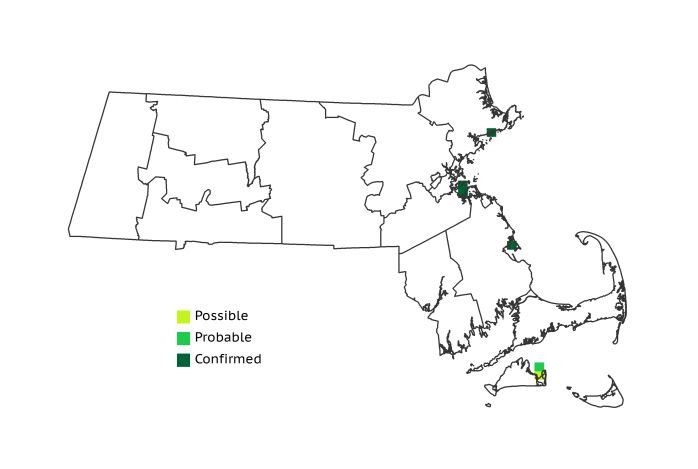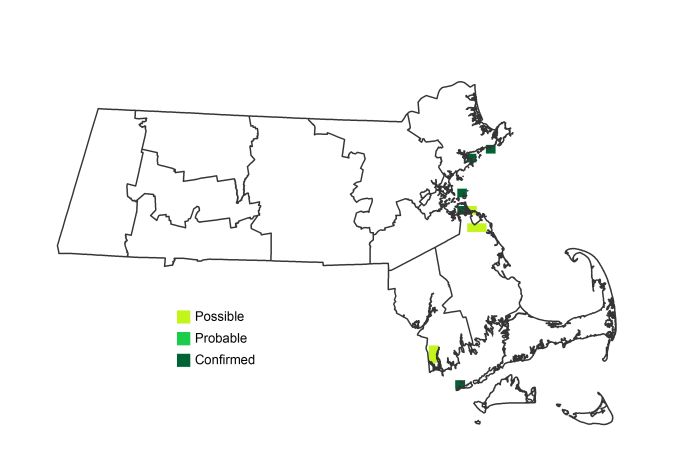Find a Bird
Glossy Ibis
Plegadis falcinellus

Very local and trend not established
“When a hurricane comes, the ibis is the last to leave and first to return.” – American folk wisdom
In Ancient Egypt, ibises were venerated as sacred birds. They were believed to have a connection to the deity Thoth, the wise scribe and lorekeeper of the Egyptian pantheon. While Glossy Ibises are not literate, they are marvelous travelers. The Western Hemisphere population of this species represents a fairly recent arrival to the New World, believed to be descendants of birds who flew from Africa to South America in the early nineteenth century (Davis & Kricher 2000).
Historic Status
The first Glossy Ibises to be seen in Massachusetts came as a shock to ornithologists in 1850, and were believed to have been assisted by a tropical hurricane (Forbush 1925). Another sighting took place on Nantucket in 1869, and a flock of 20 or so appeared before the eyes of William Brewster in Belmont in 1878. But by the 1920s (Forbush 1925), the species was still essentially considered a straggler in Massachusetts. Throughout the twentieth century, though, the bird expanded northward as a breeder. In 1947, nests were located in the Carolinas and by 1957 there were 23 colonies in New Jersey (Davis & Kricher 2000). The first Massachusetts nests were found in 1974, just as volunteers were setting out to conduct fieldwork for Atlas 1 (Petersen & Meservey 2003).
Atlas 1 Distribution
Glossy Ibises were found breeding amongst colonies dominated by Black-crowned Night-Herons and Snowy Egrets during Atlas 1. They were most numerous at the Clark’s Island and House Island heron rookeries, but were also Confirmed as breeders at 2 coastal blocks in the Boston Basin. By the end of the first Atlas period, more than a hundred breeding pairs of Glossy Ibises had been recorded in the state, and 2 occupied blocks on Martha’s Vineyard suggested that the bird’s distribution could be set to further increase.
Atlas 2 Distribution and Change
Such was not to be the case, however. Glossy Ibises lost ground in a few nesting places but gained a few others. By the end of Atlas 2, the species’ breeding distribution had increased to just 1 more Confirmation than had been recorded in Atlas 1. Glossy Ibises have ultimately stayed the course, highlighted by irregular sightings along the Massachusetts coast during the breeding seasons of the earliest days of the twenty-first century.
Atlas 1 Map

Atlas 2 Map

Atlas Change Map

Ecoregion Data
Atlas 1 | Atlas 2 | Change | ||||||
Ecoregion | # Blocks | % Blocks | % of Range | # Blocks | % Blocks | % of Range | Change in # Blocks | Change in % Blocks |
Taconic Mountains | 0 | 0.0 | 0.0 | 0 | 0.0 | 0.0 | 0 | 0.0 |
Marble Valleys/Housatonic Valley | 0 | 0.0 | 0.0 | 0 | 0.0 | 0.0 | 0 | 0.0 |
Berkshire Highlands | 0 | 0.0 | 0.0 | 0 | 0.0 | 0.0 | 0 | 0.0 |
Lower Berkshire Hills | 0 | 0.0 | 0.0 | 0 | 0.0 | 0.0 | 0 | 0.0 |
Vermont Piedmont | 0 | 0.0 | 0.0 | 0 | 0.0 | 0.0 | 0 | 0.0 |
Berkshire Transition | 0 | 0.0 | 0.0 | 0 | 0.0 | 0.0 | 0 | 0.0 |
Connecticut River Valley | 0 | 0.0 | 0.0 | 0 | 0.0 | 0.0 | 0 | 0.0 |
Worcester Plateau | 0 | 0.0 | 0.0 | 0 | 0.0 | 0.0 | 0 | 0.0 |
Lower Worcester Plateau | 0 | 0.0 | 0.0 | 0 | 0.0 | 0.0 | 0 | 0.0 |
S. New England Coastal Plains and Hills | 2 | 0.7 | 33.3 | 3 | 1.1 | 30.0 | 0 | 0.0 |
Boston Basin | 2 | 3.6 | 33.3 | 4 | 7.1 | 40.0 | 2 | 3.6 |
Bristol and Narragansett Lowlands | 0 | 0.0 | 0.0 | 2 | 1.8 | 20.0 | 2 | 2.0 |
Cape Cod and Islands | 2 | 1.5 | 33.3 | 1 | 0.7 | 10.0 | 0 | 0.0 |
Statewide Total | 6 | 0.6 | 100.0 | 10 | 1.0 | 100.0 | 4 | 0.5 |
Notes
Data from Natural Heritage & Endangered Species Program indicate a somewhat recent uptick in the number of breeding pairs in the state, from 43 in 1994/95 to 126 in 2007/08. Kettle Island and Outer Brewster Island hold the bulk of the state’s nesting pairs.



